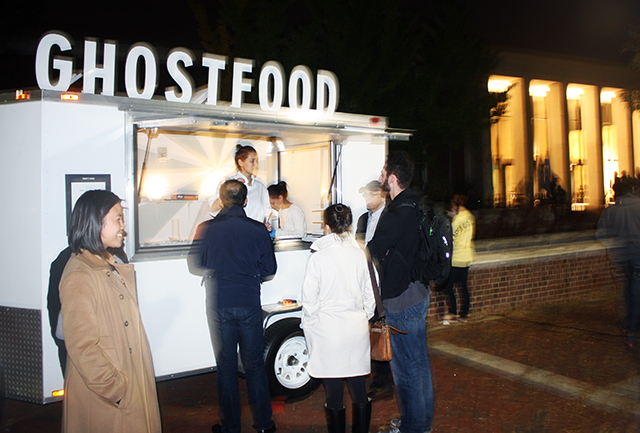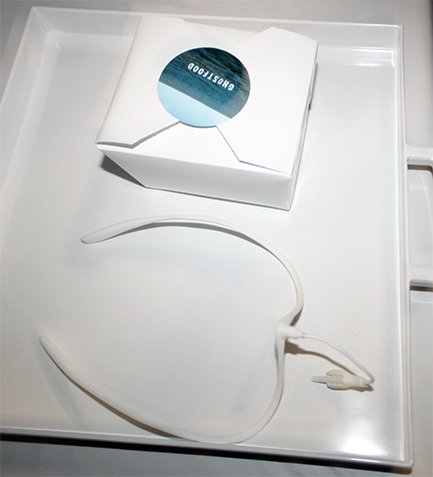Miriam Simun:GhostFood
The Contemporary, Baltimore, MD
Fall 2015
Today: Lexington Market, 400 W. Lexington St., Baltimore MD
5:00 p.m. – 9:00 p.m.
One of my favorite details from the genre of 1980s/1990s post-apocalyptic/dystopian cinema is in the opening scene of Judge Dredd. A bumbling hacker played by Rob Schneider passes a rolling drone broadcasting a PSA for slum residents: “Eat recycled food. Recycled food is good for the environment, and okay for you.” In our real, dystopian 21st century, it goes without saying that food, its future, and its relationship to class and the environment has indeed become a topic of exhaustive discourse. Many educated coastal city millennials, even those with modest incomes, religiously “splurge” on farm-to-table “real food” while the majority of the country consumes a diet of carcinogenic mystery meats and chemically-altered corn products. The frozen foods aisle has become a trench of the culture cold war, if not a generational obsession. There was a point two years ago when it seemed like there was a real risk of many Baltimore cultural institutions and MFA-holders reverting to subsistence farming as a means of maintaining relevance—or at least grants.
Given this cornucopia of food-related art projects, It’s impressive that Miriam Simun has executed a food-truck-cum-public-artwork that still manages to be really, really weird.
The project, GhostFood, is presented collaboratively between The Contemporary and Johns Hopkins University’s Curatorial Practicum and involves Simun and students serving faux-foods to the public along with bizarre headgear. The truck pops up at various locations around Baltimore, where viewers are handed a tray containing a sample portion of vegetarian imitation cod, soy butter, or sugary milk along with the apparatus. One then proceeds to a row of tables to consume the foods while the device (which looks like an ill-conceived Apple product designed to facilitate user interface via nostril) wafts the scent of fish, peanuts, or chocolate (respectively) into the wearer’s nose. During the whole process, an assistant awkwardly asks questions about the experience. Like I said, it is so, so weird.
According to the artist, the foods represent three edible species threatened by environmental disasters such as climate change. Over-fishing and warmer ocean temperatures are decimating cod populations. Heat and drought encourage parasitic fungi to attack peanut crops, rendering them toxic to humans. Global chocolate supply is already diminishing as warmer topsoil, drought, and increased vulnerability to pests in the rapidly-deforesting tropics hurt cacao trees. Within a few generations, it seems like pretty much everything on this planet will be dead or dying. These replacement foods are instead created to mimic the texture of the original using relatively climate-resilient crops. The cod, for example, is made from protein derived from taro and algae.
And it’s not all that bad. I overheard another attendee asking one of the food-truck operators what the brand was, because she wanted to purchase it. Similarly, my response during the tasting/interview was “I would totally buy this.” (I actually did, after writing an email to The Contemporary staff and finding out it can be ordered here.) Though I believe my other feedback was “the fish smell is horrible and reminds me of Chinatown in the Summer.”
That was a pretty common reaction. My boyfriend tried the peanut butter substitute and said “This is what I imagine having a snack in the scented candle aisle of a Bed Bath & Beyond is like.” Which points to one of the oddest, unmentioned aspects of the project—the smelling device adds an unpleasant sensation to two otherwise not-uncommon foods. Soy butter is already a popular alternative to allergy-triggering peanut butter, and millions of people (myself included) eat plant-based meat substitutes (sans fish-stink) daily precisely because we know that this dumb planet is running out of resources. But the “success” of GhostFood is its ability to embrace a sense of absurdist futility. It’s just close enough to reality that we found ourselves trying to rationalize the strange, sci-fi theatricality of it all as if it were a serious proposal.
It’s a great piece precisely because it presents itself in nihilistic contrast to the tropes of every phenomena it has something in common with. It’s like a surreal, doomed-to fail focus group for product R&D. It’s not coddling or patronizing like far-more-nauseating public art projects with saccharine optimism. It almost parodies the utopian, unrealistic conceptual-design-as-art-practice that always seems to be filling our newsfeeds with promises of 3D printers using ocean plastic to house refugees. As an act of “social practice” or “engaged art”, GhostFood is refreshing because it’s not patronizing or feel-good or even all that didactic. There’s a long history of institutions commissioning public representations of feeding as propaganda to project an image of philanthropy. Holbein’s altarpiece depicting Saint Elizabeth of Hungary feeding the poor comes to mind. As do all the countless recent community-gardens-as-social-sculpture that have been funded by arts organizations conflicted by their relationship with the very ruling class responsible for poverty and environmental injustice. But in Miriam Simun’s work, the empty promise is laid bare—literally whitewashed in its sterile, clinical pallette and market-research pageantry. GhostFood is kinda like the The Crass logo of Community Art—punk as fuck for its dystopian appropriation of utopian/authoritarian clichés.
But GhostFood’s absurdist nihilism is at its most biting when parodying the realm of design/product development. Of course, the solution proposed to our environmental crises brought on by consumption will be new modes of consumption. Let’s pretend we still have rainforests by using a plastic device to smell artificial cacao, ceremoniously distributed with mountains of tidy extraneous packaging, from a vehicle chugging fossil fuels. We’ll drink resource-intensive milk and nutritionally valueless sugar from the tropics. We’ve smashed all the pumpkins, but there’s a synthetically-flavored latte for that.
For a truly dystopian experience of GhostFood, check it out tonight at Lexington Market. I visited the truck when it was parked on Johns Hopkins’s bucolic knockoff-Ivy League campus, a context that reinforced the project’s R&D/institutional vibe. Lexington Market, on the other hand, is a neon-washed setting ripped from the pages of a William Gibson novel. It’s the oldest continually-operating indoor food market in the United States that’s suffered many a patchwork renovation above a brutalist subway station. And while the bazaar still fulfills its function of providing cheap street food from every continent, it also peddles discount electronics, illegal designer narcotics, bootleg DVDs, and every other escapist vice one could desire. It’s the most perfect pairing of mobile artwork and site I could imagine. The future is now. And it smells terrible.




Comments on this entry are closed.
{ 2 trackbacks }